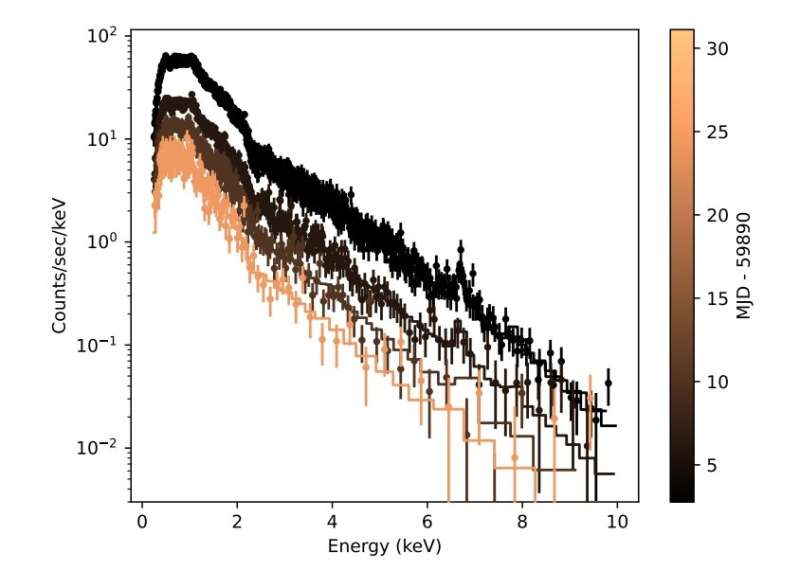Using the Neutron Star Interior Composition Explorer (NICER) and various ground-based telescopes, an international team of astronomers have performed observations of a strong X-ray superflare which occurred in 2022 on a giant star known as HD 251108. Results of the observational campaign, published Oct. 4 on the pre-print server arXiv, provide more insights into the flaring activity of this star.
Superflares are massive bursts of energy from a stellar surface. Detecting new flares of this type and studying them in detail is essential to better understand the origin of these events and the interaction between the magnetic fields and surfaces of stars.
Located some 1,646 light years away, HD 251108 is an evolved and magnetically active K-type giant star—about seven times larger than the sun. The star is relatively cool, with an effective temperature of 4,460 K, and its mass is comparable to that of the sun.
In late 2022, HD 251108 experienced a powerful X-ray superflare and a group of astronomers led by Hans Moritz Gunther of MIT Kavli Institute for Astrophysics and Space Research in Cambridge, Massachusetts, began to monitor this event in order to better understand flaring activity on single giant stars.
“We followed the decay phase of a superflare for 28 days with NICER and from the ground. We track the flare decay in unprecedented detail in several coronal temperature components,” the researchers wrote in the paper.
The observations found that the 2022 superflare on HD 251108 had a peak flux of around 10 decillion erg/s in the 0.5–4.0 keV band and an exponential decay time of 2.2 days in the early decay phase. This makes it one of the strongest flares ever observed.
Based on the collected data, the length of the flare loop was estimated to be two to four times larger than the radius of HD 251108. Moreover, about 10 days after the flare peak, the flare was found to undergo a short phase of limited re-heating and the lightcurve began to deviate from the initial decay.
The study found that chemical abundances of HD 251108 are stable throughout the flare and consistent with typical active stars with the inverse first ionization potential (IFIP) effect. The astronomers noted that during the initial decay, the X-ray light curve is matched by a decay in the hydrogen-alpha flux, while the plasma shows some re-heating.
According to the paper, HD 251108 shows rotational modulation with a period of 21.3 days. Such behavior can be explained by large stellar spots, stable for several years, but rotating in and out of view.
The observations also found that the star exhibits photometric variability of order of approximately 0.5 mag, on time scales of one or more decades of order 0.5 mag. This is consistent with these large and very stable stellar spots.
More information:
Hans Moritz Günther et al, A long-duration superflare on the K giant HD 251108, arXiv (2024). DOI: 10.48550/arxiv.2410.03616
Journal information:
arXiv
© 2024 Science X Network
Citation:
Astronomers observe a strong superflare from giant star (2024, October 14)
retrieved 14 October 2024
from https://phys.org/news/2024-10-astronomers-strong-superflare-giant-star.html
This document is subject to copyright. Apart from any fair dealing for the purpose of private study or research, no
part may be reproduced without the written permission. The content is provided for information purposes only.

